|
Special Features





Image Libraries


|
|
Blog
|

Nice and clean and empty.
Photo from pasa47 on flickr. |
Every once in a while someone tells me they like a particular city because it’s “very clean.” When that happens, what I really hear that person saying is “I judge cities by suburban standards.”
Cities are inherently messy places, and the best ones, with the most vitality, are often the messiest. If a city is too clean then it’s just an office park.
Of course, vitality means messy in the sense of being busy, which is different than messy in the sense of being dirty. But how bad do litter and grime have to become before they overwhelm one’s enjoyment of a place? Worse than in most cities, I think. Litter stinks, but a newspaper on the floor doesn’t make me want to leave the Smithsonian.
So when someone talks a lot about the cleanliness of a city, it leads me to assume they don’t spend much time in cities. That’s OK, of course. Not everyone can, nor should, nor needs to. But this is a blog about cities, and how people perceive them matters.
And being the Judgy McJudgerson urban elitist I am, that’s not the only common phrase that elicits the same reaction. Here are some more:
- “Where do you park?”
- “Traffic must be awful.”
- “Do you know about froyo?”
- “Traffic circles are so annoying!”
- “It’s a big city with a small town character.”
- “I can’t believe there’s no Walmart there.”
Got any others?
PS: In defense of those who think their strip mall’s froyo shop is unique, I suspect suburbanites think my views on lawn care are dubious at best.
Average Rating: 4.8 out of 5 based on 275 user reviews.
June 27th, 2013 | Permalink
Tags: in general

The first American-made production model streetcars in nearly 60 years are officially rolling off the assembly line, one-by-one. United Streetcar company’s first non-prototype vehicle was delivered to Portland in January, and began service earlier this month. Now, their first tram for Tucson is out of the factory and in testing.

Tucson’s streetcar. Image from the Tucson streetcar project facebook page.
United Streetcar is also producing trams for DC as part of the same production run, to be used on H Street. DC is 3rd in line behind Portland and Tucson.
United’s prototype streetcar has been running in Portland since 2012, but it’s had problems with smoothness of ride that aren’t typical for other streetcar models. The production models have a different propulsion system, so hopefully they’re better.
Average Rating: 4.9 out of 5 based on 180 user reviews.
June 26th, 2013 | Permalink
Tags: streetcar, transportation

|

Towson Row. Image from Baltimore County. |
Bethesda, Silver Spring, and Arlington are some of the best suburban downtowns in America. Baltimore’s suburbs, by comparison, have lagged behind. But with large infill projects coming to Towson and Columbia, Baltimore’s most walkable suburbs may soon catch up with DC’s.
In Towson, 1500 new residential units have opened in the past 4 years, with the largest redevelopment, Towson Row, announced just last week. The change has been enough that the Maryland Transportation Administration is now considering a Towson circulator bus network.
Columbia has further to go. Towson at least has a traditional grid of streets around which to build. Columbia, by comparison, was planned in the mid-20th Century around a mall. All Towson really needs is more buildings; Columbia must be reworked from the ground up.
|
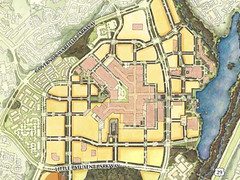 Downtown Columbia master plan. Image from Howard County. Downtown Columbia master plan. Image from Howard County. |
But they are getting there, slowly. In 2010 Howard County adopted a master plan to make downtown Columbia more urban. And now, actual projects are in the works.
Developers are moving forward with a 9-story infill project after plans for a 22-story one on the same property fell through. The shorter project is actually denser. It will have 160 apartments, 12, 000 square feet of retail, and 130, 000 square feet of office space, compared to 160 apartments, 11, 000 square feet of retail, and no office space in the 22-story version. The 22-story tower was proposed nearly 10 years ago, and was a more suburban design.
Unfortunately, for the foreseeable future both Towson and Columbia will continue to lack an important piece of the urban puzzle: regional transit. DC’s suburban downtowns have the advantage of Metro, but Baltimore’s Metro is smaller, and serves neither Towson nor Columbia. Long range plans call for an eventual light rail connection to both places, but that’s decades away.
 Cross-posted at Greater Greater Washington. Cross-posted at Greater Greater Washington.
Average Rating: 4.9 out of 5 based on 278 user reviews.
June 25th, 2013 | Permalink
Tags: bus, development, lightrail, master planning, transportation

I’m a sucker for roadside scenic overlooks. There are two on the GW Parkway in North Arlington, looking out across the Potomac. Driving along the parkway in a rental car last weekend, my wife and I decided take a look. Who knew you get a view like this, with the Washington Monument and Rosslyn together?
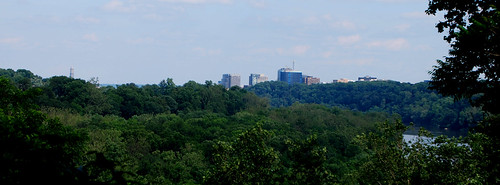
You have to step over the wall and walk into the grass to get this view. Don’t tell anyone.
Average Rating: 4.6 out of 5 based on 284 user reviews.
June 21st, 2013 | Permalink
Tags: galleries, parks

|

Herndon or Pyongyang? |
Surely when Fairfax County set about planning the Silver Line they did not intend to mimic North Korea, but it turns out there is a similarity. It has to do with Fairfax’s future Innovation Center Metro station.
Pyongyang, capital city of North Korea, has a Metro system too. In fact, like many communist-built subways, it’s quite a beautiful one. And it has an Innovation Station of its own.
Most of Pyongyang’s station names are inspirational sounding. In addition to Innovation, there’s Triumph, Glory, Paradise, Comrade, Red Star, and (my favorite) Complete Victory In Battle.
Clearly we need to up our game. Somehow, Wiehle-Reston East just doesn’t seem interesting anymore.
Average Rating: 4.7 out of 5 based on 294 user reviews.
June 20th, 2013 | Permalink
Tags: metrorail, transportation

Almost 4 in 10 DC households are car-free, and even more are car-light. That’s not because DC is full of car-hating zealots; it’s because life is simply more convenient that way, when the conditions are right.
When 5 minutes of walking, along a pleasant and safe sidewalk, can get you to most of your daily needs, and cycling or high-frequency transit can get to the rest, driving is more of pain than convenience. Especially when you factor in battling for parking and road rage, not to mention cost.
So when the Coalition for Smarter Growth started putting together Walkable Living Stories, about how and why so many DC residents go car-free or car-light, I wanted to participate. Here’s my story:
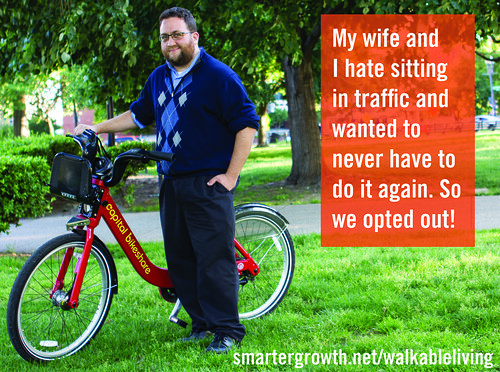
Photo from CSG.
“My wife and I hate sitting in traffic and wanted to never have to do it again. So we opted out! When we selected our apartment, we intentionally picked one in the densest part of DC. Within two blocks of our apartment we have a grocery store, convenience mart, dry-cleaner, hardware store, and several cafes. So almost all our daily errands are on foot, or Capital Bikeshare. My commute is on the 16th St. bus line, where buses come every few minutes (more often than Metro trains!), so we never have to wait long. And we never have to look for parking, because we don’t need any! Our apartment costs more than one in the suburbs would, but we don’t have a car payment, nor an insurance payment, nor any gasoline bills. We do occasionally rent cars for out-of-town trips, but that’s much less hassle and cost than car ownership.”
For more about CSG’s Walkable Living Stories project, visit their website, or see today’s big GGW post.
Average Rating: 4.8 out of 5 based on 216 user reviews.
June 19th, 2013 | Permalink
Tags: people, The New America, transportation

How’s this for a visible sign of our impending streetcar overlords?
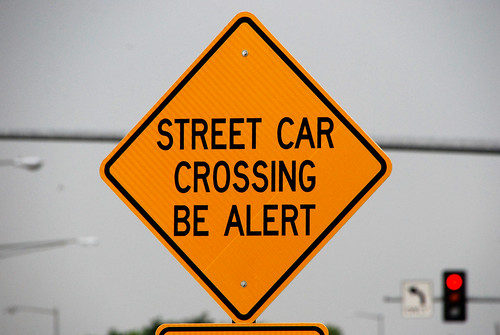
Another view, in context.
The sign is on South Capitol Street, where streetcar tracks from Firth Sterling Avenue curve to head south towards Bolling Air Force Base and the DDOT streetcar commissioning track.
Back in 2011 I speculated we would soon have signs like this in DC. I haven’t noticed any on H Street, although it’s possible I’ve just missed them.
Average Rating: 4.5 out of 5 based on 176 user reviews.
June 18th, 2013 | Permalink
Tags: streetcar, transportation

Outside of Tysons Corner, Vienna MetroWest is Fairfax County’s greatest experiment yet in transit oriented development. But now it appears developers have scaled back, and may build car-oriented retail instead.
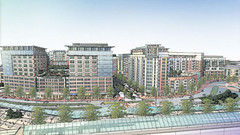 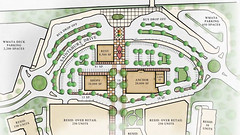
Original plan (left), and current plan (right). Images from Clark Realty and Paraclete Realty.
MetroWest was initially approved in 2006 after years of debate as a dense, walkable town center adjacent to Vienna Metro station. It was Fairfax County’s first big smart growth win.
With construction of the residential sections underway, the town center seemed close to finally, finally happening. But now that it’s time to actually start leasing spaces, the town center development plan looks a lot different.
Instead of dense, walkable midrises, the are single-story retail buildings surrounded by surface parking lots. Instead of an urban town center, it’s a glorified strip mall. What happened?
One can speculate. A recession hit, competing developments at nearby Dunn Loring Metro opened first, and the market changed.
Developers do often build single-story retail as a “temporary” placeholder until they’re ready for more intense uses. That was the idea behind the Kentlands town center in Gaithersburg, which is now redeveloping parcel by parcel. But “temporary” in this case can mean 20 years.
For people who bought homes at MetroWest based on the promise of a strong town center nearby, the potential of something better years in the future is little consolation.
 Cross-posted at Greater Greater Washington. Cross-posted at Greater Greater Washington.
Average Rating: 4.8 out of 5 based on 256 user reviews.
June 14th, 2013 | Permalink
Tags: development, land use

I’ve never seen anything like Moscow’s Zhivopisny Bridge before. It’s technically a cable-stayed bridge, like many around the world, but the giant perpendicular archway pier is totally unique.
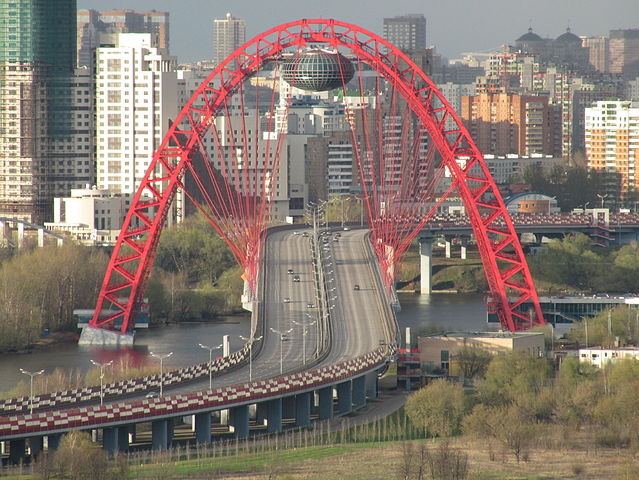
Photo from Wikipedia user Daryona.
Average Rating: 5 out of 5 based on 214 user reviews.
June 12th, 2013 | Permalink
Tags: architecture, roads/cars, transportation

|
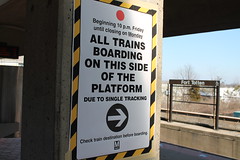
Photo from Elvert Barnes on flickr. |
Unlike its off-peak trains, Metrorail’s rebuilding program is moving full steam ahead. When will it actually be done?
After years of deferred maintenance, WMATA is neck deep with major track work every weekend. The work is clearly necessary for Metrorail’s long term viability, but it’s awful for riders now.
With headways approaching 1/2 hour, weekend service is maddeningly inconvenient. God help anyone needing to transfer.
Part of the problem is there’s no light at the end of the tunnel. Riders don’t know how long they’ll have to put up with construction. There have been vague references to 2017 as when Metro may return to normalcy, but most riders haven’t heard that, and those who have don’t know what it actually means.
Thus, the Washington Post today published an editorial calling on WMATA to publish deadlines, so the riding public has a better idea of what to expect.
Highway agencies publish deadlines for road work. Maryland’s MTA published deadlines when it closed portions of Baltimore’s light rail in 2004. Why can’t Metro?
Deadlines “inspire confidence, ” says Post writer Robert Thomson, “especially when they are met.”
Unfortunately, WMATA General Manager Richard Sarles so far refuses. In a 2012 Google+ Hangout that the Washington Post organized, Greater Greater Washingotn’s David Alpert and Michael Perkins asked Sarles to give more specifics about the timeline for rebuilding; he declined.
With respect to Mr. Sarles and to the complicated problems he’s charged with solving, that’s not good enough. Metro exists to serve customers, and it’s not serving them well right now.
The long term viability of the system depends as much on the good faith of riders as it does on the status of tracks. We know Metro has to be rebuilt, and that doing so means some inconveniences. Most of us can live with that. But the more confident we are that this painful time will end someday, the better we can support Metro in the meantime.
 Cross-posted at Greater Greater Washington. Cross-posted at Greater Greater Washington.
Average Rating: 4.7 out of 5 based on 281 user reviews.
June 11th, 2013 | Permalink
Tags: metrorail, transportation

|
Media





Site
About BeyondDC
Archive 2003-06
Contact
Category Tags:
Partners
|


























